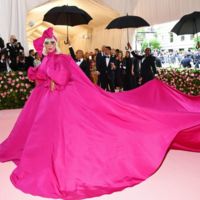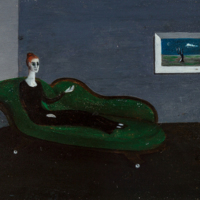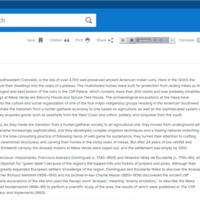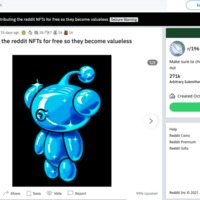Browse Exhibits (34 total)
Lost Opportunity: The Death of a Mars Rover

In June of 2018 the Mars rover, Opportunity, was caught in the middle of an increasingly bad dust storm. The storm blocked out the sun leaving Opportunity in complete darkness.
Despite hundreds of recovery commands sent to the rover, NASA was unable to reach Opportunity.
On February 13, 2019, after eight months without a response, NASA officially anounced Opportunity's mission complete.
News of the "death" of Opportunity spread across social media with thousands of people mourning the loss of the rover.
The 2019 Met Gala

Officially titled the Metropolitan Museum of Art Costume Institute Benefit, the Met Gala is the largest fundraiser for the museum. It is an exclusive--expensive and invitation-only--event. Guests arrive wearing custom couture in the theme of the event, which usually matches the opening of the Costume Institute's exhibit.
2019's theme was Camp: Notes on Fashion, after Susan Sontag's essay "Notes on Camp". The hosts were Harry Styles, Serena Williams, Alessandro Michele, and Anna Wintour, the editor-in-chief of Vogue. The event was held on May 6th, 2019 in New York City.
"Cash App me!"
This exhibit is dedicated to contemporary digital items associated with Cash App created by Square, Inc. Cash App is a peer to peer payment service used to send money or bitcoin. Anyone with a smart device can use Cash App for any reason. Cash App has gathered attention that includes the positive and negative press. It truly is up to the user how to use Cash App, and this exhibit shows a combination of news articles and popular culture references that showcase Cash App and its influence.
The Commercialization of Frida Kahlo
Frida Kahlo is a world-recognized and celebrated Mexican artist. She is now recognized as a feminist icon for the way she challenged heteronormativity and beauty ideals. Her transformative power as an icon is often portrayed through objects of consumerism. This collection is to help reflect if the commercialization of Frida Kahlo captures the sexual and cultural values that elevated her to the icon we know today or has it transcended her into a cultural product that only represents a set of values attached to fame and popularity?
Women of Surrealism

“People talk about surrealism as an art movement, like abstract expressionism or impressionism. Surrealism is a philosophical movement” – Dorothea Tanning
Women Surrealists are women artists, photographers, filmmakers and authors connected with the Surrealism movement, which began in the early 1920s. To this day, the names and works of the huge number of important women artists throughout the world are missing in many reference guides and survey exhibitions on Surrealism. Seeing them together, we gain better insight into the international network, the incredible diversity and the impressive independence of both the better and lesser-known women artists of Surrealism
The 30 artworks created by 6 female Surrealists in this digital collection, several of whom have been long overlooked and excluded from the male-dominated art historical canon, present a wealth of work by historical women across a century.
The Trump Administration's Family Separation Policy
Summary
This collection includes born digital items relating to the Trump Administration's family separation policy which was in effect from April 2018 to June 2018. The core idea of the family separation policy was to take a zero-tolerance approach to immigration. This approach was then intended to help deter further illegal immigration. Border officials prosecuted and held migrant adults in federal jails, but in doing so, they separated migrant parents from their children. This policy included any migrants crossing at the border; migrants legally coming to the border to request asylum were also charged in criminal court. By the time the policy ended in June 2018, the official number of children separated from their parents was 4368. Former first lady Laura Bush compared the situation it to the internment camps for people of Japanese descent during World War II which she described as “one of the most shameful episodes in U.S. history.”
This topic was chosen due to the lasting effects the policy will have on the migrants involved and because of its influence on future U.S. immigration policy decisions. Items within the collection include videos, images, illustrations, Twitter posts, journal articles, news stories, and audio files.
We Keep Each Other Safe: Mutual Aid in the United States of America during the COVID-19 Pandemic
In 1902, philosopher Peter Kropotkin published an essay collection entitled Mutual Aid: A Factor of Evolution. Although this was not the first use of the term, his book popularized the idea of mutual aid, stating “As soon as we study animals…we at once perceive that though there is an immense amount of warfare and extermination going on amidst various species… there is, at the same time, as much, or perhaps even more, of mutual support, mutual aid, and mutual defence amidst animals belonging to the same species or, at least, to the same society.”
Indeed, the practice of mutual aid—of neighbors helping neighbors— is an ancient one; nevertheless, the COVID-19 pandemic and resulting economic decline has seen a heightened interest in mutual aid. Hundreds of funds and networks have been established around the United States in an attempt to respond to increased need due to shelter in place orders, disrupted food supply chains, and massive job loss (14.7% as of May 2020). The nature of COVID-19 has forced many of these networks to primarily function online, resulting in a plethora of born digital resources documenting these hyper-local, community based efforts. Online aid request forms, marketing materials, and community agreements chronicle the work of neighbors helping neighbors. Tweets, YouTube videos, and articles draw attention to the ways in which civilians have fulfilled needs where more formalized institutions have failed.
This collection includes resources which best illustrate the principles, practice, and influence of Mutual Aid networks across the United States of America as a direct response to the COVID-19 Pandemic in an attempt to document this work for future generations.
Theatre in the Time of a Pandemic

The nature of theatre and the performing arts relies on telling a story with the performers and audience members gathered together in the same room at the same time. However, what happens when a pandemic shuts down a society and threatens the culture that defines the community? How does the theatre industry respond when those social gatherings it depends on are prohibited? Theatre and all types of performances were one of the first industries to shut down when the COVID-19 pandemic began in March 2020. This collection looks at how performers, both from history and the last year, have found ways to bring entertainment to communities when it was most needed in order to continue telling their stories. From ancient Grecian amphitheaters to Roman street performers, history is filled with detailed examples of how performers have adjusted or pivoted when faced with a challenge. The COVID-19 pandemic has once again provided performers a fresh opportunity for ingenuity that will have lasting implications on not only the theatre industry but our culture. By looking at past pandemics and how our current world has reacted to entertainment during COVID-19, we can gain insight into the future direction of theatre.
The goals for this collection include:
-To highlight the changing methods that performers have utilized to express their emotions
-To preserve examples of digital performances and the progression of the different pandemic performance styles
-To provide future pandemics insight into how theatre in the 21st century endured and survived this latest pandemic
Pandemics are worldly and affect performers irregardless of skill level or location. To demonstrate the worldly impact and the universal need to create, the items in this collection originate from several countries within North America, South America and Europe. It contains interviews, articles and audio-visual materials that describe the creation process, the resulting performances, and any potential or actual lasting effects. However, since many performances were only available with a ticket or live attendance, whether in person or online, this collection contains mostly articles and interviews that describe the works and less of the works themselves.
Finally, because the COVID-19 pandemic will continue until most of the world is vaccinated, this collection will remain open to additions as they become available.
Mesa Verde National Park

This collection of materials is publically available on the 115th Year Anniversary of the Mesa Verde National Park.
In this collection you will find photos, articles, hyperlinks to videos and websites.
The Goals For This Collection:
1) To connect those who are interested in native lands to become interested in visiting this National Park.
2) Showcase artifacts that were stolen from this sacred place and those who were asked to return them.
3) To acknowledge the Pueblo people that created the magnificent structures and cliff dwells in the Four Corners Region.
4) Digitally preserve what is currently known about the indigenous people who built and fled this place. In order to help preserve an oral heritage.
In this collection you will discover the volumn of materials that are made possible because of the National Park Service preservation efforts. Mesa Verde National Park Service strives to restore, protect, and preserve this sacred location and acknowledge this sacred land. This is done by employing indigenous people and respecting requests from the native community in the four corner region.
Welcome!
The Popularity and Trajectory of Non-Fungible Tokens

Non-fungible tokens are one-of-a-kind, non-repeatable digital transferable assets existing in the blockchain, cryptocurrency ecosystem. The beginning of 2021 and peaking in March 2021, NFTs rose in popularity and became the subject of intense discussion due to the issues and implications for the art market and beyond. Some of these issues include: environmental impact, the perception of value, and lack of quality assurance.
This collection aims to explore some of those issues as well as the origins and future of NFTs. The artifacts collected are from digital news and commentary articles, social media posts, and YouTube videos.